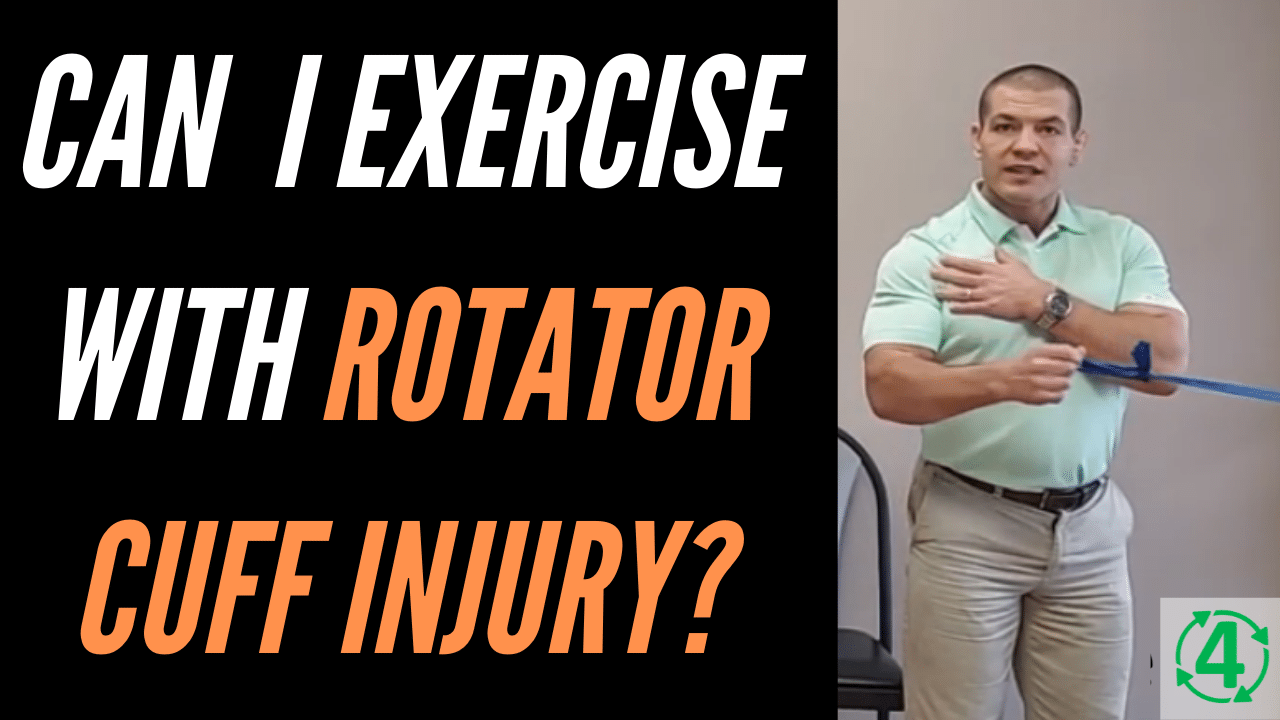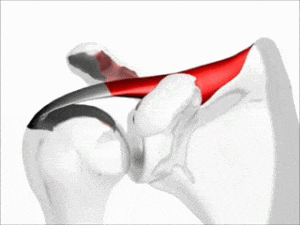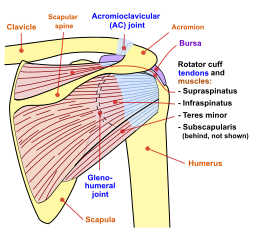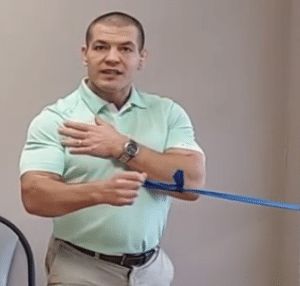Wonder If It's Safe To Exercise With A Rotator Cuff Injury?
Watch the video to learn what exercise to do & which exercises to avoid with rotator cuff injury.

Is It Safe To Exercise With Rotator Cuff Injury?
The short answer is: You can exercise with a rotator cuff injury safely.
The longer answer is that it depends: Some exercises are almost always safe to do, some are sometimes good to do, and there are some exercises to avoid with rotator cuff injury.
If you're an active person and you enjoy exercising, you may be nervous to exercise with a rotator cuff injury for fear of making it worse. In this post, you'll learn:
- Which exercises are safe to do with a rotator cuff injury?
- Can I run with a rotator cuff injury?
- What exercises aggravate rotator cuff injury?
- Exercises to strengthen rotator cuff
- How to stretch rotator cuff muscles
- How to get back to exercise as quickly as possible after a rotator cuff injury
What Exercises Are Safe To Do With Rotator Cuff Injury
It Is Safe To Do Aerobic Exercise With Rotator Cuff Injury
If you have a rotator cuff injury, general aerobic exercise that uses you lower body such as walking, biking, or using an elliptical (+/- arms) are nearly always safe to do.
These aerobic exercises increase blood flow through the body and therefore provide more blood flow, nutrients, and oxygen to the shoulder to help the rotator cuff heal.
Can I Run With Rotator Cuff Injury?
Often you can run with a rotator cuff injury, but not in all cases. Running should be safe to do with a small rotator cuff tear, but if you have a severe traumatic rotator cuff tear, the jarring and bouncing motion of running may be uncomfortable.
What About Strengthening Exercises?
Upper body strengthening exercises like biceps curls and triceps pushdowns are safe to do with a rotator cuff injury in most cases.
You DO need to use your rotator cuff to stabilize your arm while doing biceps curls and triceps pushdowns, so it it hurts, the lighten the weight. If that doesn't help, then find a different exercise.
What Exercises Aggravate Rotator Cuff Injury?
The strengthening exercises that aggravate rotator cuff injury are ones where the arms are raised above shoulder level with the arm in an internally rotated position.
What does that mean?
It means exercises where you raise your elbows higher than your hands such as:
-
Upright rows
-
Power cleans
-
Lateral raises with your thumbs down
Why do these exercises aggravate rotator cuff injury?
Your shoulder is a ball-and-socket joint. However, the ball isn't a perfectly round ball.
The ball has bumps on it, and when you lift your elbows above your shoulders with your elbows higher than your hands, you can pinch the rotator cuff tendons under the arch of the shoulder and aggravate your rotator cuff.
What Exercises Help Rotator Cuff Injury?
Physical therapy exercises for rotator cuff injury generally fall into two different types of categories:
Strengthen Rotator Cuff Exercises
There are many different exercises to strengthen the rotator cuff. To understand the best exercises to strengthen the rotator cuff though it first helps to understand what the function of the rotator cuff is.
Function of the Rotator Cuff
The rotator cuff is made of 4 different muscles. Collectively, their job is to do 2 things:
- Rotate the ball of the arm bone (humerus)
- Keep the ball of the humerus centered in the socket (glenoid fossa) as you move your arm.
The most common rotator cuff strengthening exercises that you seen in most physical therapy clinics focus on this first action: rotating the arm bone.
In this type of exercise, the rotator cuff is the prime mover - the muscle creating the desired action.
These actions are:
- External rotation - rotating the humerus away from he midline of the body
- Internal rotation - rotating the humerus toward the midline of the body
However, it's rare in real life that we use our arms in pure rotational motions
How We Really Use Our Rotator Cuff Muscles
The more common way we use our rotator cuff muscles in real life is the second action mention above:
To keep the ball of the humerus centered in the socket while other bigger, stronger muscles act as the prime movers to move our arms.
Furthermore, it's usually failure to use our rotator cuff muscles in this way that contributes to shoulder pain.
So if that's the case, shouldn't rotator cuff strengthening exercise attempt to strengthen the rotator cuff the way it's used in real life?
That just makes sense.
At More 4 Life, we believe in doing things that make sense, not just blindly following what everyone else is doing.
And that's why we get great results for our patients with shoulder pain... because we do thing differently.
Need Some Help For Shoulder Pain?
Click the button below to request a Free Shoulder Pain Discovery Visit
How To Stretch Rotator Cuff Muscles
When your rotator cuff muscles are stiff they can limit range of motion and cause when raising your arms or reaching behind your back.
This is particularly true with 2 of the rotator cuff muscles in the back of your shoulder: the infraspinatus and teres minor.
When these muscles are stiff, they push the ball of the shoulder forward in the socket and can cause pinching of the rotor cuff tendons or the biceps tendon.
So How Do You Stretch The Rotator Cuff Muscles?
There's an exercise called the "Sleeper Stretch" where you lay on your side and internally rotate your arm.
This can be a good stretch for the rotator cuff muscles. However, if the ball of the shoulder isn't centered in the socket (which it probably isn't if you need to do this exercise in the first place), then you may get pain when stretching.
Click here to learn a modified version of the sleeper stretch for stiff rotator cuff muscles.
What Other Stretches Help If You Have A Rotator Cuff Injury?
If other muscles besides the rotator cuff can also contribute to shoulder pain.
Some of these muscles include:
Click on the links above to learn how to stretch these muscles.
Will Doing Rotator Cuff Exercises Help Shoulder Pain?
While rotator cuff exercises may be one part of recovering from shoulder pain, it's important to find the root cause of the shoulder pain and correct it.
Otherwise, once you stop doing your exercises (and let's face it... most people DO stop doing their exercises once they feel better), the shoulder pain can come back.
Want To Get Back To Exercise After A Rotator Cuff Injury?
If you'd like discover how to get rid of your shoulder pain as quickly as possible so that you can get back to exercise, plus how to keep pain from coming back in the future, click the button below to request a Shoulder Pain Discovery Visit with one of our specialists






